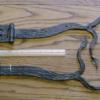-
Posts
685 -
Joined
-
Last visited
Profile Information
-
Gender
Male
-
Location
Palmer Alaska
Converted
-
Location
Palmer Alaska
-
Interests
hunting, fishing
-
Occupation
farrier, blacksmith, beekeeper
Recent Profile Visitors
7,614 profile views
-
Looks like it has been a month since this has seen any action. A couple thoughts. The farther the grip is from the rivet the more universal the tong can be, also the less powerful the grip. Since it appears you may be new at making tongs I would think you might be better off copying simple tongs to build your skills then going into making a new design.
-
I think maybe Jay copied the tongs from Champion.
-
I know a guy who makes a lot of knives from old saw blades. They are quick and not a lot of time in fit and finish, however he seems to be making a good living making them. He does not heat treat them, he is just careful not to get them hot while making them. he uses both logging saws and carpentry saws. He told me that the logging saws were more problematic as they were often bent around a pack horse load to get then into the mountains. He also stated that sometimes when cutting out the blade shape they would fracture and that was the end of that blade, I think when he had a problem he moved on rather than waste time on a lost cause, anyhow they work for him.
-

Late bloomer wants to make Damascus drop point blades
metalmangeler replied to thresher's topic in Knife Making
Thomas's Idea to use a drop while you wait for that really low priced anvil sounds really good. -

Late bloomer wants to make Damascus drop point blades
metalmangeler replied to thresher's topic in Knife Making
I think buying tools at really low prices is great when you can but maybe $6 per pound is not that bad, when you are producing nice Damascus I would like to get some I will pay up to $8.00 per pound. Just a random thought, don't delay too much waiting for a tool at 1960 prices. Your time is really what is valuable. -
Ben I am rooting for you, if that power hammer works it will change your production in an unbelievable way. Also your elbows might last.
-

Portable hole / drifting block
metalmangeler replied to CactusBob's topic in Anvils, Swage Blocks, and Mandrels
For sledge work lower would be better. -
I buy my rivets as much as possible. If I understand your question I think you would be better off to drill a hole the length rivet you want then upset the head that is not enclosed by the hole you could make a heading tool to make your upset domed if that is your desire, however if you are going to the trouble to make your own rivets I would think you should make them more special than the cheap ones you could buy. That heading tool should have a custom design that is yours......if you keep the heading process while the rivet is hot it should drop out after it cools, much like making a hardy tool.
-

H13 steel for blacksmithing tools
metalmangeler replied to lyuv's topic in Tools, general discussion
Snuffy I am using my forging hammer for striking tools, I expect my tools to be soft enough that this should not cause a problem. My hammers are mostly either 4140 or truck axles tempered somewhere between straw and light bronze. Just getting to nonmagnetic is not hot enough to be hardening with an air quench on H13. If you go from just finished forging to heat treat with out cooling you likely will end up with a tool too hard on the struck end. My soft hammers are more for helping people with poor hammer skills learn to forge. As far as making a mandrel from H13 for say axe eyes it might make sense if you are planning on lots of axes if you are only going to make half a dozen or something I would not bother. I made quite a few tools from H13 before I ever used a power hammer, the steel is hard forging but the end product holds up well, you should be able to forge it by hand. I would be sure I knew what I wanted my mandrel to look like before I made one from a high alloy steel. -
It will need to be hotter than the steel for welding. Just something to keep in mind.
-

Ready to Learn! Any tips?
metalmangeler replied to BigsbyTheBear's topic in Alaska Blacksmith Association
I would recommend you make it to the meeting on the 27th. -

Rivet Heading / Upsetting Tool
metalmangeler replied to bobasaurus's topic in Tools, general discussion
My rivet heading tools have the spring on the bottom so they sit well in the vice. I made them with one tool for each size, less options more tools. I really like having the shoulders on my rivet heading tools. I also have tendon tools I have not used them interchangeably. -
Is there a planned demonstration? If there is what is the plan, and who will be executing it?
-
I just saw this I will be praying for you and her and her family.
-

H13 steel for blacksmithing tools
metalmangeler replied to lyuv's topic in Tools, general discussion
I have been using H13 for around 30 years. It is my favorite steel for making tools I expect to abuse by getting too hot. The method described by Frank Turley has worked for me for long tools that I do not need to get the whole tool hot in making. (though the struck end may work harden and will need to be dressed from time to time.) For a handled tool like a hammer eye punch you will need to get the back of the tool back down to not too hard or you might be joining some of Gerald's friends down at the ER. Here is how I harden my tools I know this is not as good as it could be but it has worked for me. I use a tempil stick to gauge my heat, after forging my tool I set ti aside, it will be hard all over when cool, I use a gas forge, so you may need to make some adjustments but I take my tool back to harden without anealing, (I know this is not correct, just trying to keep it simple) I put the end I want to harden into the fire, with the back taking a lesser heat, the end I want hard needs to get to 1825F I want the back end to get to nonmagnetic. I will let air cool, I think the optinum temp for hardening quench is 60f in still air I go with whatever the temp is in the shop. We rarely get to 75f here. I expect these tools to get too hot that is why I make them from H13 so I normally do not temper them. (I also know this is not correct, but this steel has been pretty forgiving in this area for me.) after the tool is cool I test with protective gear on to see if I met my goals for hardness and a softer striking end, setting the punch or hot cut to cut a A36 plate and checking to make sure my hammer dented the stuck end. No doubt this can be done better, but it has worked for me, since you already have the steel you might want to try this with a small piece to see if you think it will work for you. The most common problem I see other people have with this steel is after forging their tool they let it air cool and do not know how to get the back end down to soft enough to be safe. At nonmagnetic an air quench does not harden H13 it needs to be more like the 1825F.





